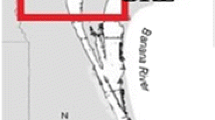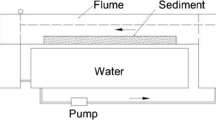Abstract
We investigated metallothionein (MT) induction in the talitrid amphipod Talitrus saltator, a well-established biomonitor of trace metal contamination in the supralittoral environment, in response to laboratory exposure to Hg, Cd, or Cu for 3, 6, 24, and 48 h. Analyses were also carried out on animals collected in the wild from six localities along the Tuscan coast with different degrees of trace metal contamination. Animals exposed to Hg in the laboratory showed a strong dose-dependent increase of MT levels after 3 and 6 h; in the following hours (24 and 48 h), the MT concentrations reached control levels, possibly due to a general toxic effect of Hg. For the other metals, MT induction was observed in animals exposed to 10 ppm of Cd and 5 and 10 ppm of Cu. Therefore, despite the positive correlation between MT concentrations and trace metals in sandhoppers collected in the wild, the fast MT response observed in the laboratory suggests an inappropriate use of MT as biomarkers to assess trace metal pollution in coastal areas.


Similar content being viewed by others
References
Amiard, J. C., Amiard-Triquet, C., Barka, S., Pellerin, J., & Rainbow, P. S. (2006). Metallothioneins in aquatic invertebrates: their role in metal detoxification and their use as biomarkers. Aquatic Toxicology, 76, 160–202.
Barka, S., Pavillon, J.-F., & Amiard, J. C. (2001). Influence of different essential and non-essential metals on MTLP levels in the copepod Tigriopus brevicornis. Comparative Biochemistry and Physiology Part C, 128, 479–493.
Bodar, C. M. W., Kluytmans, J. H., Van Montfort, J. C. P., Voogt, P. A., & Zandee, D. I. (1998). Cadmium resistance and the synthesis of metallothionein-like proteins in Daphnia magna. In: Proceedings of the Third International Conference of Environmental Contamination (pp. 79–81) CEP Edinburgh.
Bowen, R. E., & Depledge, M. H. (2006). Rapid assessment of marine pollution (RAMP). Marine Pollution Bulletin, 53, 631–639.
Del Ramo, J., Torreblanca, A., Martinez, M., Pastor, A., & Diaz-Mayans, J. (1995). Quantification of cadmium-induced metallothionein in crustaceans by silver-saturation method. Marine Environmental Research, 39, 121–125.
Fialkowski, W., Rainbow, P. S., Fialkowska, E., & Smith, B. D. (2000). Biomonitoring of trace metals along the Baltic coast of Poland using the sandhopper Talitrus saltator (Montagu) (Crustacea: Amphipoda). Ophelia, 52, 183–192.
Fialkowski, W., Rainbow, P. S., Smith, B. D., & Zmudzinski, L. (2003). Seasonal variation in trace metal concentrations in three talitrid amphipods from the Gulf of Gdansk, Poland. Journal of Experimental Marine Biology and Ecology, 288, 81–93.
Fialkowski, W., Calosi, P., Dahlke, S., Dietrich, A., Moore, P. G., Olenin, S., et al. (2009). The sandhopper Talitrus saltator (Crustacea: Amphipoda) as biomonitor of trace metals bioavailability in European coastal waters. Marine Pollution Bulletin, 58, 39–44.
Geffard, A., Quéau, H., Dedourge, O., Biagianti-Risboug, S., & Geffard, A. (2007). Influence of biotic and abiotic factors on metallothionein level in Gammarus pulex. Comparative Biochemistry and Physiology Part C, 145, 632–640.
Lafabrie, C., Pergent-Martini, C., & Pergent, G. (2008). Metal contamination of Posidonia oceanica meadows along the Corsican coastline (Mediterranean). Environmental Pollution, 151, 262–268.
Mardsen, I. D., & Rainbow, P. S. (2004). Does the accumulation of trace metals in crustaceans affect their ecology—the amphipod example? Journal of Experimental Marine Biology and Ecology, 300, 373–408.
Martinez, M., Del Ramo, J., Torreblanca, A., Pastor, A., & Diaz-Mayans, J. (1996). Cadmium toxicity, accumulation and metallothionein induction in Echinogammarus echinosetosus. Journal of Environmental Sciences and Health A, 31, 1605–1617.
Mouneyrac, C., Amiard, J. C., Amiard-Triquet, C., Cottier, A., Rainbow, P. S., & Smith, B. D. (2002). Partitioning of accumulated trace metals in the talitrid amphipod crustacean Orchestia gammarellus: a cautionary tale on the use of metallothionein-like proteins as biomarkers. Aquatic Toxicology, 57, 225–242.
Nassiri, Y., Rainbow, P. S., Amiard-Triquet, C., Rainglet, F., & Smith, B. D. (2000). Trace-metal detoxification in the ventral caeca of Orchestia gammarellus (Crustacea: Amphipoda). Marine Biology, 136, 477–484.
Rainbow, P. S. (2002). Trace metal concentrations in aquatic invertebrates: why and so what? Environmental Pollution, 120, 497–507.
Rainbow, P. S., & Moore, P. G. (1986). Comparative metal analysis in amphipod crustaceans. Hydrobiologia, 141, 273–289.
Rainbow, P. S., Moore, P. G., & Watson, D. (1989). Talitrid amphipods (Crustacea) as biomonitors for copper and zinc. Estuarine, Coastal and Shelf Science, 28, 567–582.
Rainbow, P. S., Amirad-Triquet, C., Amiard, J. C., Smith, B. D., Best, S. L., Nassiri, Y., et al. (1999). Trace metal uptake rates in crustaceans (amphipods and crabs) from coastal sites in NW Europe differentially enriched with trace metals. Marine Ecology Progress Series, 183, 189–203.
Roesijadi, G. (1992). Metallothioneins and metal regulation and toxicity in aquatic animals. Aquatic Toxicology, 22, 81–114.
Siegel, S., & Castellan, J. N., Jr. (1989). Nonparametric statistics for the behavioral sciences. New York: McGraw Hill.
Ugolini, A., Felicioni, S., Ruffo, S., & Cipriani, L. (1995). Distribution of Talorchestia ugolinii and other sandhoppers in Corsica. Bollettino di Zoologia, 62, 291–296.
Ugolini, A., Borghini, F., Calosi, P., Bazzicalupo, M., Chelazzi, G., & Focardi, S. (2004). Mediterranean Talitrus saltator (Crustacea, Amphipoda) as biomonitor of heavy metal contamination. Marine Pollution Bulletin, 48, 526–532.
Ugolini, A., Borghini, F., Focardi, S., & Chelazzi, G. (2005). Heavy metals accumulation in two syntopic sandhopper species: Talitrus saltator (Montagu) and Talorchestia ugolinii Bellan Santini Ruffo. Marine Pollution Bulletin, 50, 1328–1334.
Ugolini, A., Ungherese, G., Somigli, S., Galanti, G., Baroni, D., Borghini, F., et al. (2008). The amphipod Talitrus saltator as a bioindicator of human trampling on sandy beaches. Marine Environmental Research, 65, 349–357.
Ungherese, G., & Ugolini, A. (2009). Sandhopper solar orientation as a behavioral biomarker of trace metals contamination. Environmental Pollution, 157, 1360–1364.
Ungherese, G., Baroni, D., Bruni, P., Focardi, S., & Ugolini, A. (2007). Esposizione al rame e concentrazione di metallotioneine in Talitrus saltator. Biologia Marina Mediterranea, 14(2), 414–415 (In Italian).
Ungherese, G., Baroni, D., Focardi, S., & Ugolini, A. (2010). Trace metal contamination of Tuscan and east Corsican supralittoral zones: the sandhopper Talitrus saltator (Montagu) as a biomonitor. Ecotoxicology and Environmental Safety. doi:10.1016/j.ecoenv.2010.06.021.
Usero, J., González-Regalado, E., & Garcia, I. (1997). Trace metals in the bivalve molluscs Ruditapes decussatus and Ruditapes philippinarum from the Atlantic coast of southern Spain. Environment International, 23(3), 291–298.
Usero, J., Morillo, J., & Garcia, I. (2005). Heavy metals concentrations in molluscs from Atlantic coast of southern Spain. Chemosphere, 59, 1175–1181.
Viarengo, A. (1989). Heavy metals in marine invertebrates: mechanisms of regulation and toxicity at the cellular level. CRC Critical Review in Aquatic Sciences, 1, 295–317.
Viarengo, A., & Nott, J. A. (1993). Mechanisms of heavy metal cation homeostasis in marine invertebrates. Comparative Biochemistry and Physiology Part C, 104(3), 355–372.
Viarengo, A., Ponzano, E., Dondero, F., & Fabbri, R. (1997). A simple spectrophotometric method for metallothionein evaluation in marine organisms: an application to Mediterranean and Antarctic molluscs. Marine Environmental Research, 44(1), 69–84.
Viarengo, A., Burlando, B., Dondero, F., Marro, A., & Fabbri, R. (1999). Metallothionein as a tool in biomonitoring programmes. Biomarkers, 4(6), 455–466.
Weeks, J. M. (1992). Copper-rich granules in the ventral caeca of talitrid amphipods (Crustacea; Amphipoda: Talitridae). Ophelia, 36(2), 119–133.
Weeks, J. M., & Rainbow, P. S. (1993). The relative importance of food and seawater as sources of copper and zinc to talitrid amphipods (Crustacea; Amphipoda; Talitridae). Journal of Applied Ecology, 30, 722–735.
Acknowledgements
The research was financially supported by the Fondazione Monte dei Paschi (Siena) (grants 33,798 assigned to A. Ugolini), by MOMAR (Sistema integrato per il monitoraggio e il controllo dell’ambiente marino, IT-FR Marittimo. Project co-funded by European Regional Development Fund, ERDF) and by Fondazione Cassa di Risparmi di Livorno (Livorno) (2010 Settore Arte–Educazione–Salute–Ricerca Scientifica). Thanks are due to the Ente Parco Regionale di Migliarino, San Rossore, Massaciuccoli (Pisa) for authorization of the sampling. We also wish to thank Dr. Diego Bonomo for his technical assistance during the laboratory analysis.
Author information
Authors and Affiliations
Corresponding author
Rights and permissions
About this article
Cite this article
Ungherese, G., Baroni, D., Bruni, P. et al. Metallothionein Induction in the Sandhopper Talitrus saltator (Montagu) (Crustacea, Amphipoda). Water Air Soil Pollut 219, 343–351 (2011). https://doi.org/10.1007/s11270-010-0711-7
Received:
Accepted:
Published:
Issue Date:
DOI: https://doi.org/10.1007/s11270-010-0711-7




